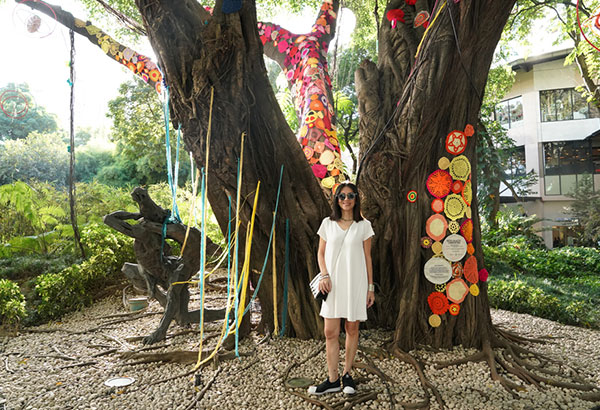How Lulu Tan-Gan covered the Greenbelt Gardens in knitwear

Lulu Tan-Gan with the Retro Galactic Communitree: “Being in a public space, the exhibit has the power to touch people of different ages and backgrounds. I’d like to encourage the people to explore traditional crafts as they are partly the backbone of our culture and foundation of textile design.”
Queen of Knitwear Lulu Tan-Gan kick-started the Greenbelt + Ayala Museum Experience G.A.M.E. with an explosion of creative energy, “Yarn Bomb Knit Bomb.” Chunky woolen yarns in groovy psychedelic colors and retro patterns are knitted on, crocheted, macraméd, and woven onto Greenbelt Gardens’ large tree trunks, boulders on the ponds, and even the many lampposts.
“Through this, Ayala Museum and Ayala Malls redefine the museum experience, bringing art outside of the gallery and to the outdoors,” said Ayala Museum senior director Mariles Gustilo, summing up this series of designer and artist collaborations.
Ayala Malls Group assistant vice president and area head of Central Manila Joseph Reyes adds, “The mall is more than just a place to shop and hang out, it’s also a creative hub where you can discover new things and explore new concepts.”
But for Tan-Gan, there’s more to the story. A pioneer of merging Philippine artisan sophistication with contemporary design — as well as the slow fashion and sustainable fashion models we see making their resurgence today — Tan-Gan uses hand-loomed knitting. Its craft and artistry does not require electricity. When Tan-Gan joined Greenbelt 5’s Filipino row at the end of 2007 as L Manila, the venue presented a bigger opportunity for the brand to expand its advocacy.
“Our advocacy was to revive the use of our indigenous fabrics, in particular, piña, in a contemporary form, functional, relevant, and not as a native costume,” Tan-Gan says. “As a designer brand that has been around for some years, we have a role to play. If we were able to bring out the piña out of the ‘barong’ closet, we definitely should initiate, inspire and be an influencer.”
During the first two years of L Manila and venturing into Piñawear (adding piña to her knits), Tan-Gan explained what piña is and the value of hand-weaving to the majority of her customers, Filipino and foreign. “Being at the mall brought piña the exposure to the average shopper,” she says.
Tan-Gan saw G.A.M.E. as a chance to revive the other side: “Hand-textile traditional crafts, not traditional indigenous fabrics.” There are no traditional patterns used. “Tinguian motifs were posted over the retro striping, just as an inspiration motif. Even on a tree, my intention is still to showcase current fashion and not tribal nor traditional weaves, which already has its place with very successful local and global campaigns.”
She adds that in the digital age we live in, millennials are no longer exposed to handmade traditional crafts. “Being in a public space, the exhibit has the power to touch people of different ages and backgrounds,” she says. “I’d like to encourage the people to explore traditional crafts as they are partly the backbone of our culture and foundation of textile design. I myself began this career with the power of this traditional craft. Until this day, it’s what keeps the brand alive. The world has gone around from handmade to industrial manufacturing. Now the artisanship is back. Traditional crafts can start as a hobby. Oftentimes quite therapeutic, a form of de-stressing; but one can take that further and build a business out of it, which also supports livelihood.”
Knitting as one
The Greenbelt Gardens is divided into areas descriptively called Retro. “This was an era wherein crochet and knitting was revived and quite popular for about two decades,” she says. The areas are the Retro Tribo Walk (distinguishable for its Tinguian motifs in turquoise, aquamarine and navy), Retro by the Chapel (in lavender, blue and natural circular mantel-like crochets and hand-woven fabrics), Retro Walk from the museum to the chapel (trees, lamps, and boulders on the pond in graphic knit stripes and circles), and Retro Galactic Communitree (graphic multicolored knit and crochet circles by the 25 craft hobbyists on Ayala Museum’s Balete tree).
Tan-Gan employs her textile-based approach to the outdoor installation. “I had to make sure that it could withstand the natural elements, constant rain and harsh sunlight,” she explains. The plan was to use 100-percent-natural fibers to still showcase indigenous fabric but tests showed that it would just absorb rainwater only to collapse. Those used for her clothing line, while sturdy enough, are way too fine.
“It would take us until the year 2018 to launch the exhibit.” Bulkier woolen yarns are ideal. Used in “Yarn Bomb Knit Bomb” is a combination of those she used for export in the ’80s from her archives, donated kilos of bulky woolen yarns used to produce Tai Ping rugs from Evelyn Lim, and online yarn retailer Gantsilyo Guru and the Manila Bay Thread team.
Given the intricacy and craftsmanship of its scale, the five Retros come alive as both the canvas and subject in hundreds of hands. Tan-Gan received over a hundred submissions from knit and crochet hobbyists and chose the top 25 based on their submitted required circular samples.
For knitting, it was a shared effort between Tan-Gan’s artisans and hand-knitters in the Ifugao region, led by Candy Reyes of Knitting Expedition. For crochet, it was the Manila Bay Thread team. For weaving, Tan-Gan tapped the Benilde fashion students through their Fabric Design class project, where each student hand-wove a 12” x 10” fabric using five to seven materials in varying textures of their choice, all in natural colors. “I required them to use natural-colored materials only so they could sharpen their visual sensitivity and feel for texture — without the distraction of color,” she explains.
“Since the crochet and knit enthusiasts were all volunteers from different walks of life such as lawyers, mothers, and IT analysts, my first challenge was the time element,” Tan-Gan recalls. “I was facing a group of busy hobbyists. They would work on the craft to de-stress. I wasn’t sure if the deadline would be met. For volunteers that were extra-motivated, they were given an option to ‘personal a tree.’ They installed their own smaller tree by the chapel.”
The mathematics of art & design
Tan-Gan planned the space and match-made the trees and crafts. “I could easily measure the 20 skinny bamboo trees by the Banana Republic and the Chapel. But the 10 major trees, the arborists of the Ayala Gardens would help measure with their tall ladders. In spite of the photos and measurements, we made a dozen trips to the garden, constantly retaking photos, studying the space and different angles of the trees, lampposts and rocks, and considering the space from one tree to the next,” she details. “Most of all, we thought, can we hand-make all the pieces?”
She then translated the tree measurements to knit count. “To get the correct knit count or stitches, one needs to calculate the horizontal and vertical stitches per inch, which is similar to the Excel’s rows and columns. Knit also stretches depending on stitch design, tension and density. Tricky, if one is not familiar,” she says.
Once all knit pieces were completed, they had 10 days to hand-seam them onto trees, rocks and lamps. “We lived in the Greenbelt Gardens and M Café for those 10 days, rain or shine. I underestimated the time it would take us to hand-seam the knit pieces and did not account for November rainy days. For the crochet pieces, I had to lay out the 600 pieces based on tree shape and size.” Greenbelt horticulturist Francis Suarez and his team of gardeners — even Tan-Gan’s chauffeur — were a big help. “Two days before the launch of the exhibit, we had to re-measure the main tree (the Retro Galactic Communitree). This time, more specific in circumference, every one to two meters, aiming for three six-footer heights. At least 18 feet high.”
As for personal favorites, Tan-Gan admits she has none. “I designed the space as one entity. I have no favorite tree or area, as one area wouldn’t be complete without the other,” she says. “Maybe it’s how I am wired as a designer. When I design a collection, each look and piece forms part of the collection, just like a puzzle.”
It’s an approach calling for a walkthrough of the gardens with the occasional pause and reflection. “Yarn Bomb Knit Bomb” is exciting visual art that you can touch and feel!
* * *
“Yarn Bomb Knit Bomb” is on view in the Greenbelt Gardens until Jan. 14, 2018. For more information, visit www.ayalamuseum.org.



















